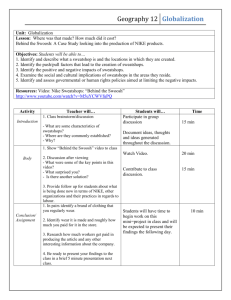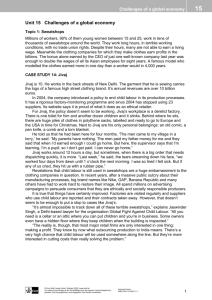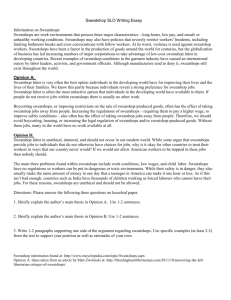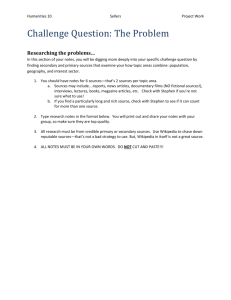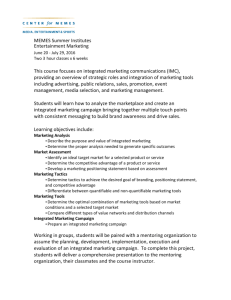Trainers Guide - Global Exchange
advertisement
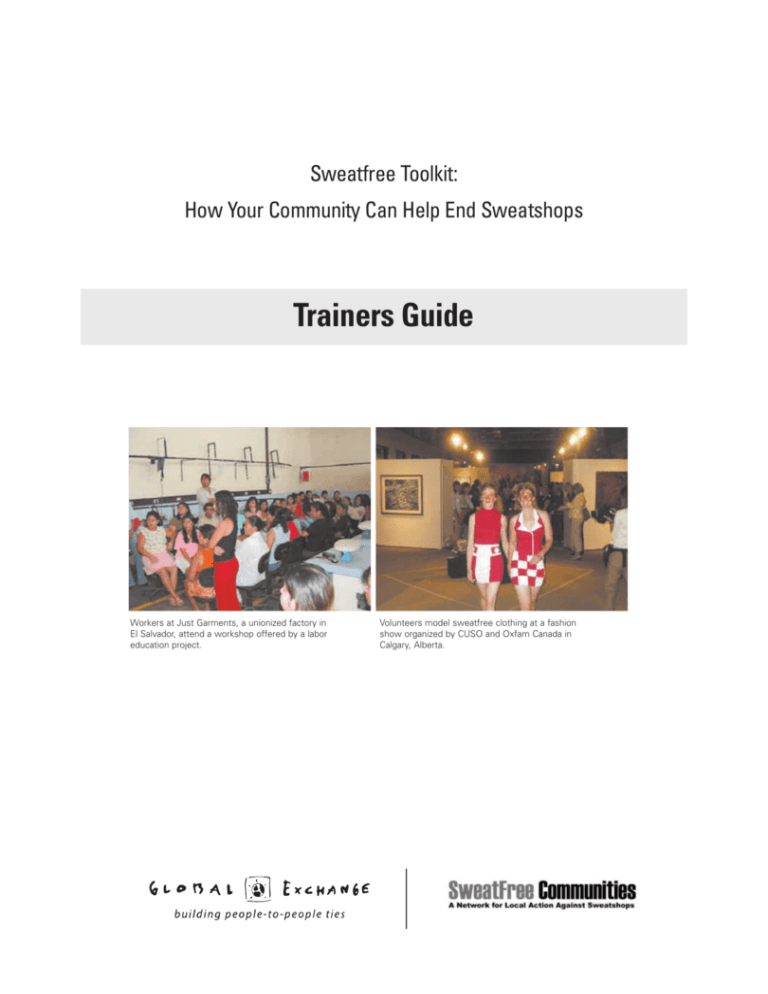
Sweatfree Toolkit: How Your Community Can Help End Sweatshops Trainers Guide Workers at Just Garments, a unionized factory in El Salvador, attend a workshop offered by a labor education project. Volunteers model sweatfree clothing at a fashion show organized by CUSO and Oxfam Canada in Calgary, Alberta. Workshop Overview Introductions Opening activity/ community building exercise Designing the agenda Ex. Checking the Label . . . . . . . . . . . . . . . . . . . . . . . . . . . . . . . .51 This packet includes many activities to choose from in creating a workshop. The activities you choose should depend on time allotted and the audience. For a group of high school students, who are not yet working on a campaign, a 2 hour workshop might include: Checking the Label, Sweatshops Brainstorm, Stakeholders in the Garment Industry, Crunching the Numbers, and Action Brainstorm. Ex. Sweatshops and Us Bingo . . . . . . . . . . . . . . . . . . . . . . . . .52 Identifying knowledge in the room Ex. Sweatshops Brainstorm . . . . . . . . . . . . . . . . . . . . . . . . . . .54 Ex. Checking the Label Debrief Questions . . . . . . . . . . . . . . .51 Building knowledge For a group of people (youth and adults alike) who are dedicated to working on a sweatfree campaign, a 2-3 hour workshop might include: Answering Difficult Questions, The Nitty Gritty of a Sweatfree Campaign (Parts 1 and 2), and What is in a Sweatfree Policy? Ex. Answering Difficult Questions . . . . . . . . . . . . . . . . . . . . . .54 Ex. Crunching the Numbers . . . . . . . . . . . . . . . . . . . . . . . . . . .55 Ex. Stakeholders in the Garment Industry . . . . . . . . . . . . . . .56 In order to lead “What is in a Sweatfree Policy?” the facilitator should be familiar with the Sample Sweatfree Code & Policy and have some familiarity with a few policies that have been adopted. These resources are available online at www.sweatfree.org. To lead “Trade Rules Behind the Scenes” the facilitator should be comfortable talking about international trade agreements and rules on government procurement that are in the negotiating process. Ex. Trade Rules Behind the Scenes . . . . . . . . . . . . . . . . . . . . .57 Ex. What is in a Sweatfree Policy? . . . . . . . . . . . . . . . . . . . . .58 Planning for action Ex. The Nitty Gritty of a Sweatfree Campaign . . . . . . . . . . . .59 PART 1: Sweatfree Campaign Overview PART 2: Making an Action Plan for Your Community During the workshop, it is helpful for the facilitator to provide examples of current sweatfree campaigns and how institutions with sweatfree policies have played a key role in successful international solidarity campaigns. Ex. Action Brainstorm . . . . . . . . . . . . . . . . . . . . . . . . . . . . . . . . .60 Closing and Evaluation • Summarize main points With any activity, it is important for the facilitator to be able to openly acknowledge it when they do not know the answer to a question. Identifying unanswered questions gives us our “to do” list. Bring contact information for resource organizations to point people to who want to learn more. • Pass out literature • Publicize upcoming events, meetings, actions Resources consulted in developing this packet: “CWS Workshop Guidelines” by Challenging White Supremacy Workshop. “FTAA for Beginners: Trainers Guide” (2001) by United for a Fair Economy. National Labor Committee, www.nlcnet.org. “Outsourcing: The Fair Globalization Solution” (2004) by United for a Fair Economy. Rethinking Globalization (2002) by Rethinking Schools. “Stop Sweatshops Educator's Handbook” (2000) by Maquila Solidarity Network. The Checking the Label activity is widely known. Trade Rules Behind the Scenes was developed by Sara Johnson of Public Citizen. The other activities in this workshop guide were developed by Liana Foxvog of SweatFree Communities. WWW.SWEATFREE.ORG 413.586.0974 | WWW.GLOBALEXCHANGE.ORG 415.558.6938 49 Advance preparation Having answers to these questions in advance will help you prepare. What is the space like? Is there room to move around? Movable chairs so small groups can gather? Is amplified sound needed? With a small or medium size group, it is nice to sit in a circle. How many people? The design of the activities is different depending on numbers – In a large group, it may make sense to lecture more and to have a co-facilitator to help with the interactive parts. Who is the audience? Age? Constituency – students, union members, social justice organizers, faith-based, unemployed, outsourced workers? Current involvement in a sweatfree campaign or in other social justice work? Do they know each other already? At the workshop: In the beginning of the workshop, give a few minutes for a quick go around, in which each participant to shares their name, group, and current involvement in sweatfree organizing. This will give you idea of who is in the room, and how to target your message. Popular education We strive to use the popular education method in our workshops. This includes: • Challenging unequal power relations and drawing on people's experience by recognizing that everyone – participants and facilitator alike – can share, teach, and learn. • Orienting people toward a cycle of action and reflection by providing organizing tools. Creating Anti-Racist Group Dynamics As facilitator, you set the tone of the workshop. Actively working to build an anti-racist and anti-sexist dynamic in the group will help create a comfortable environment where people are heard and where learning and creative discovery takes place. In our economic justice work, we seek to challenge oppression and injustice in our society. One small and yet profound way to do this in our own groups is by challenging educational models and group 50 WWW.SWEATFREE.ORG 413.586.0974 | dynamics that value some voices more than others. These are facilitation practices that can help create an equitable group dynamic and comfortable learning environment: • In a workshop where people do not know each other, and especially with a diverse group of people, a good practice is to post the workshop guidelines below on the wall and review them in the beginning. Even if you do not post them on the wall, in your introduction to the workshop, it is useful to state your intention for group dynamics. • When people raise their hands to speak, first call on people who have not spoken before. Prioritize the voices of people who are part of social groups that are traditionally silenced–people of color, youth, women, people with disabilities, openly LGBT people. • In the beginning of the workshop, it is good to mention that you hope to engage everyone's participation and that you recognize that everyone brings experience and questions to the room. Later on, if someone is dominating the discussion, you can remind the group of the intention established in the beginning. • When a number of people want to talk at once, it is useful to call “stack”. Give each of them a number – giving numbers 1 and 2 to people who have been heard less – and then call through the numbers. If the point was already made, encourage participants to pass when it is their turn. Workshop Guidelines: • Speak from your heart and experience. Use “I” statements. • We are not here to judge each other, put each other down or compete. • Listen to the wisdom everyone brings to the group. • Give each person the time and space to speak. • Practice active listening. Respect the person. Challenge the behavior. • Prioritize voices of youth, women, people of color, quiet people. • Step up if you are often quiet. Step back if you find yourself speaking a lot. WWW.GLOBALEXCHANGE.ORG 415.558.6938 Checking the Label (10-30 minutes) Materials: world map taped on wall, post-its This hands-on and participatory activity is widely used by anti-sweatshop educators. It works well as an opening activity and as a way to get to deeper conversation about the sweatshop economy. Depending on the group you are working with, it may be wise to survey the group to see if they have done the activity before. Pass out post-its, one per person. Ask the participants to pair up and check one label on each other's shirt or shoes, write the brand name and the country of manufacture on the post-it, and pin it to the world map. Variation: If the audience is large, participants can shout out the countries and volunteers mark the map. Talking point before the exercise: • We are looking to identify what countries our clothing comes from. This is not about judging anyone due to where their clothes are made. In fact, most major brands make most of their clothes in sweatshops. Debrief questions and talking points (depending on time, choose a couple or go through all): • Corporate profit: What parts of the world are the brands based in? Companies put much more of their money into advertising and trying to “brand” us than they do into worker wages. In fact, garment worker wages are often only 1% of the store price. • Race to the bottom: What parts of the world were most of the clothes made in? Why these countries? The race to the bottom refers to corporations seeking cheaper and cheaper places to produce their goods. • Sweatshop conditions: Imagine the person who made your clothes. What do you think their working conditions are like? • Made in USA: Whose clothes are made in the USA? Does anyone's label say “Union Made”? Made In USA does not equal sweatshop-free. The overwhelming majority of garment workers in the U.S. are immigrant women. In fact, the Department of Labor estimates that more than 50% of the garment factories in the U.S. are sweatshops. Also, many clothes marked “Made In USA” are sewn in U.S. territories in conditions of indentured servitude. Sweatfree sources of clothing are currently few, but they do exist both in the U.S. and abroad, and we can build the numbers by organizing. When we buy products made by worker owned or unionized workplaces we know that workers have a voice on the job, even if they are in the midst of struggling to improve conditions. • The global system: The map gives us a glimpse at the global production system. What rules and conditions have to be in place for a global production system like this to work? WWW.SWEATFREE.ORG 413.586.0974 | WWW.GLOBALEXCHANGE.ORG 415.558.6938 51 Sweatshops and Us Bingo (10-15 minutes)2 Materials: Copies of Sweatshops and Us Bingo Card. This is a great interactive ice-breaker, especially in a group where participants do not know each other. Participants wander around and introduce themselves to each other while collecting signatures from people for whom the statements are true. Encourage participants to move on to another person after one or two questions. Depending on time and number of participants, make the goal either who can complete their card first or who can complete a row first. The Bingo Card is included on the next page. A few answers to the points on the card: Places that have achieved sweatfree policies are listed at www.sweatfree.org Triangle Shirtwaist Factory fire: On March 26, 1911, 146 workers, mostly young women, died in the fire that was one of the greatest industrial tragedies in U.S. history. ILO: International Labor Organization. Three brands: Any major brands that are not known as union-only, are using sweatshops. Union in US: UNITE HERE organizes garment workers (and other industries) in the US. Travel: Remember, the U.S. also counts as a country with sweatshops. WRC: Worker Rights Consortium, an independent monitoring organization started by the U.S. student anti-sweatshop movement. See www.workerrights.org for more info. Key policy elements: Some key elements are: no child labor, right to unionize, ILO standards and local laws, factory disclosure, non-poverty wage, compliance for contractors and subcontractors, independent monitoring, etc. For more detail, see SweatFree Communities Sample Code & Policy. Debrief: Any surprises? Any questions? 2 Ideas for “Sweatshops and Us Bingo” borrowed from “Stop Sweatshops Educator's Handbook” by Maquila Solidarity Network (2000), and “Outsourcing: The Fair Globalization Solution – Participant Handout Packet” (2004) by United for a Fair Economy. 52 WWW.SWEATFREE.ORG 413.586.0974 | WWW.GLOBALEXCHANGE.ORG 415.558.6938 Sweatshops and Us Bingo Card I know one source of sweatfree clothes I know of a city or school where organizers have achieved a sweatfree policy I am a union member I have written a letter to a company that uses sweatshops I know what ILO means I know what union in the U.S. organizes garment workers I can name 5 countries that have sweatshops I am wearing a shirt made in another country I want to be active in a sweatfree campaign I am a garment worker I know someone whose job was outsourced I buy second hand clothes I do not have health insurance I have bought university apparel with a logo I can name an anti-sweatshop organization I have heard of the Triangle Shirtwaist Factory fire I know what a “maquila” is I have invested in a company that outsources I can name three brands that use sweatshops I speak more than one language I know someone who has worked in a sweatshop I have spent time in a country that has sweatshops I have chosen to not buy a particular brand because of their labor practices I know the key elements of a sweatfree purchasing policy I know what the WRC is WWW.SWEATFREE.ORG 413.586.0974 | WWW.GLOBALEXCHANGE.ORG 415.558.6938 53 Sweatshops Brainstorm (10-15 minutes) This activity will bring out knowledge and experience that participants bring to the room, and give them an opportunity to see each other as resources. It should help you as facilitator determine what information is important to cover during the session. Use only with small or medium size groups. Ask the following two questions of each participant, going around the room: • What is one thing you know about sweatshops? • What is one question you have? Points to make after the go-around: • As we can see from this quick survey of information in the room, we already have a lot of collective knowledge and experience. • During the workshop, let's keep these questions in mind, and please raise them again if they are not addressed during the course of the workshop. Before moving on to the next activity, take a moment to correct any inaccurate information that was given during the brainstorm and see if there are any pressing questions that cannot wait. Write up responses on the board, including inaccurate information. Answering Difficult Questions (20-30 minutes) Opening: “Have you ever been stumped by a challenging question when talking with a friend about sweatshops? In this exercise we will identify some of the myths about the sweatshop economy and learn how to respond to common questions that we hear as organizers. First, let's brainstorm together...” I. Brainstorm: What are some myths or challenging questions about anti-sweatshop work that you've heard? See the attached sheet titled “Answering Difficult Questions” for some ways to respond to these questions and further resources. If necessary, after the brainstorm, go through the questions with the group, and discuss ways to respond. Some examples that we have heard: Workers take the jobs, so they must be fine, right? A sweatshop job is better than nothing II. Roleplay Sweatshop workers are already paid enough by the standards of the country where they work After the brainstorm and ensuing discussion, divide the group into pairs. Person A is a sweatfree organizer. Person B is a skeptical but curious friend, who will ask some of the common questions. Ask them to roleplay for a few minutes. Then call time and have partners switch roles, again for a few minutes. If participants are not very familiar with anti-sweatshop organizing, it works well to divide people into four person discussion groups, with two as organizers and two as skeptical friends. Do not boycotts hurt workers, so what’s the point? Sweatfree costs too much My shirt says Made in U.S., so that's good, right? Sweatshops are a natural stage of economic development Some of these questions, such as those about cost and Made In U.S., stem from misinformation. It is important to provide the group facts that will give them the information to be able to respond to these questions in an educational way. Some of the common questions show a lack of understanding about organizing strategy. For example, the anti-sweatshop movement rarely calls for boycotts and only as a last resort as part of a larger strategy. Organizing is focused on leveraging consumer and political power to pressure companies to work 54 toward fair labor conditions. Many common questions come out of an individualist, rather than a collective, approach. Rather than spending workshop time discussing where each of us individually should buy from, it is important to emphasize that where we make a difference is through collective organizing, and keep the focus on education about sweatfree purchasing policies and the difference they can make. WWW.SWEATFREE.ORG 413.586.0974 | III. Debrief After the roleplay, bring the group together for a debrief discussion. What questions were the hardest to answer? Why? What additional information do you need to be an informed and articulate sweatfree advocate? If you did not already discuss the questions one by one in the large group, this is a good point to do it, so that unfamiliar students can catch up to more advanced students. To finish, pass out copies of the “Answering Difficult Questions” handout. WWW.GLOBALEXCHANGE.ORG 415.558.6938 Crunching the Numbers (10 minutes) A little bit of sweatshop economy math can be illuminating for the group. Facilitators will see eyes widen during this activity. I. Many sweatshop workers earn the minimum wage for their country. In many countries, the minimum wage is only a percentage of the estimated living wage. Workers are not asking for much. They want to be treated with dignity and earn enough to feed their children. What if we doubled the worker wage – what would be the new price of the item? "Get workers involved in making the Code of Conduct. Pay a living wage, about $102 (per month for the basic wage), and improve health and safety standards (gloves and masks, ergonomic chairs, end sexual harassment)." – Antoni Silo, Indonesian labor organizer on what Nike needs to do II. Who profits from sweatshops? Example: In 2003, workers at a Honduras factory who sewed for rapper Sean John “P. Diddy” Combs earned a total of $0.15 per shirt. The same t-shirts were sold in the U.S. for $40. If the wage of Honduran workers was doubled and all other costs remained the same, what would be the new store price? Answer: The new store price is $40.15. In many groups, one of the first answers we hear is often $80 – when these participants are corrected they are usually amazed at how little the price goes up and wonder why companies do not have the heart to pay higher wages. In this example, the wage of garment workers is less than half a percent of the store price of shirts they sew. (Anyone still stumped by the calculation can look here: Of the original $40 store price, $0.15 went to workers. So $39.85 went to other costs and profits. To double the worker wage, we add another $0.15 to the price. $40 + $0.15 = $40.15.) Present these numbers to students and have a discussion about the wide inequality gaps. You can ask the group to guess the numbers. After one guess, write down the actual number. • In 2004,4 golfer Tiger Woods won a $100 million endorsement deal from Nike. • Nike CEO Phil Knight earned a total compensation of $4.2 million in 2004. • In 2003, Phil Knight ranked 31st richest person in the U.S. with a worth of $5.8 billion.5 • The hourly wage of Indonesian Nike workers: $0.17.6 • Their annual wage is $444.7 • In 1999, it was estimated that there are 80,000 Nike workers in Indonesia.8 It would cost $35.5 million to double the yearly wage of Nike Indonesia workers. Do you think Nike can afford that? Why does not Nike pay workers more? What can we do to change that? 3 The Sean John data is from the National Labor Committee, www.nlcnet.org/campaigns/setisa 4 “Nike endorsements up to $1.7B” CNN Money. August, 2, 2004. http://money.cnn.com/2004/08/02/news/fortune500/nike_endorsements/ (Tiger Woods and Phil Knight compensation data.) 5 6 7 8 Rankin, Deborah. “Trust Raises Millions from Nike Stock Sale.” Portland Tribune. November 25, 2003. In the end of 2004, Phil Night retired from his CEO position. Research conducted by Educating for Justice in 2000. http://www.educatingforjustice.org/nikewages/workerswages.html Taking monthly wage provided by Educating for Justice: $37 x 12 months = $444 per year. “Behind the Swoosh: Facts About Nike,” by the Victoria International Development Education Association (VIDEA), www.videa.ca WWW.SWEATFREE.ORG 413.586.0974 | WWW.GLOBALEXCHANGE.ORG 415.558.6938 55 Stakeholders in the Garment Industry (10–20 minutes) Draw a table on the board. Title the sections: Brand CEO, Workers in poor country, US consumers, US factory workers. Ask participants what they they think the interests of each of these different groups are. Write in bulleted key points. Below is an example of what the table might end up looking like. Brand CEO US consumers • maximize profits • minimize costs • build brand loyalty • cheap goods • good quality • cool brands • (fair labor conditions?) Workers in poor country US factory workers • decent treatment and dignity on job • receive full wages that are owed • ability to afford food, housing, healthcare • ability to organize union without repression same basic needs as poor country workers + higher expectations of benefits, etc. Questions and discussion: • Once the brainstorm is over, we often add “fair labor conditions?” in the US consumers category. Why did not anyone list this during the brainstorm? Do you think that many consumers buy with a conscience? Why not? • Are there any conflicting interests between these stakeholders? Give anyone who raises their hand a marker and ask them to come to the board to mark conflicting interests and provide a brief explanation to the rest of the group. • Dismal working conditions are a direct result of company interests in maximizing profits and minimizing costs. The way to interrupt the race to the bottom is to organize large purchasers to not tolerate sweatshop-made goods and build a market for fair labor standards. • Notice that the interests of garment workers in poor countries and in the United States are mostly the same. We need to overcome protectionist inclinations imposed on us by the corporate media. Everyone has a right to a decent job. By building labor solidarity alliances across borders we can show that it comes down to the interests of the people vs. the interests of the corporations, and that the people's interests are universal. What are some examples of global solidarity work? • What laws and regulations protect these stakeholder interests? Examples: ILO rules protect workers' right to unionize and to collective bargaining. In many places local laws also protect union rights and set limits on work day length. The rules of the World Trade Organization and bilateral and regional free trade agreements support company interests of maximizing profits: Their laws do not include enforceable worker rights provisions. Furthermore, they provide international tribunals where companies can challenge environmental and labor laws that might be seen as a “barrier to trade”. 56 WWW.SWEATFREE.ORG 413.586.0974 | WWW.GLOBALEXCHANGE.ORG 415.558.6938 Trade Rules Behind the Scenes (30-45 minutes) This activity should be led by a facilitator who has a working familiarity with trade agreements and rules related to government procurement. Ideally, there would be two facilitators, one to partner with each group. Divide half the group into CEOs and half the group into citizens. Hand roles to CEOs (different companies: General Motors CEO, Gap CEO, Nike CEO, Monsanto CEO, etc.) and to citizens (auto factory worker, garment worker, farmer, schoolteacher, union organizer, etc.). Give each group 10-15 minutes. The CEOs should come up with five rules to govern global trade based on their self interests. The citizens should come up with five purchasing policies for their state to help protect their self interests and social justice beliefs. Here is an example of what the group might come up with: Purchasing policies All products purchased should meet SweatFree Communities Sample Policy Mandatory preference for products and services produced in the state Mandatory preference for organic products Mandatory preference for “green” products, i.e. recycled content, renewable energy (Mandatory preference = state has to buy it if it is available) Trade rules Investor rights without restrictions for businesses Free movement of goods and services (no tariffs) Preferential purchasing policies are illegal Right to get a redress for unfair treatment in the marketplace Voluntary codes of conduct and self monitoring Follow the exercise with a presentation about what exists in current trade agreements and information about agreements in the negotiation process. Provide information about key clauses in the SweatFree Communities Sample Policy. This activity is based on a workshop Sara Johnson of Public Citizen led at SweatFree Communities' May 2003 conference. For more information about trade rules related to government procurement, consult www.citizen.org or contact Public Citizen at 202-588-1000. For more educational activities about free trade, see United for a Fair Economy's workshops available through www.faireconomy.org: “Globalization for Beginners” and “FTAA for Beginners”. WWW.SWEATFREE.ORG 413.586.0974 | WWW.GLOBALEXCHANGE.ORG 415.558.6938 57 What is in a Sweatfree Policy? (30-45 minutes) Materials: Copies of Core Elements of a Sweatfree Procurement Policy and Sample Code & Policy, both produced by SweatFree Communities, and available at www.sweatfree.org and in the SweatFree Communities Organizing Guide. Often in workshops the goal is to inspire people to dedicate themselves to learning more and taking action. With that kind of group, this activity is not appropriate. Other groups will already be building a sweatfree campaign and are interested in more specific technical information, and for them this is a useful activity. After doing a quick Sweatshops Brainstorm, go into these following discussion questions. If some members of the group are familiar with the information, draw out their expertise. In other groups, you may only get limited responses to the questions from the audience. Nonetheless, ask the questions – it is how you identify knowledge in the group. Then proceed to give short presentations on each question where needed. Questions for discussion and presentation: What rules currently govern manufacturing and trade? (ILO, local laws, international trade agreements) What can we achieve with sweatfree purchasing policies? What are the key elements of a sweatfree purchasing policy? What is the reasoning behind them? Activity options: • Pick a few elements to focus on in your presentation. • Pass out Core Elements of a Sweatfree Procurement Policy (short version). Give participants 10 minutes to read it. Ask for clarifying questions and base your presentation off the questions. • Divide the group into smaller groups and give each group one section of the Core Elements of a Sweatfree Procurement Policy to study and discuss. After 10 minutes, ask each group to give a brief presentation on their section to the larger group. Between presentations, add in clarifying information and answer outstanding questions. Allow time for further discussion on what we can achieve with sweatfree policies. (For an exercise on how to achieve a sweatfree policy, see The Nitty Gritty of a Sweatfree Campaign.) 58 WWW.SWEATFREE.ORG 413.586.0974 | WWW.GLOBALEXCHANGE.ORG 415.558.6938 The Nitty Gritty of a Sweatfree Campaign (1 hour) PART 1: Sweatfree campaign overview (30 minutes) Review the goal of a sweatfree purchasing policy: An institutional sweatfree procurement policy is, in large part, a movement-building tool, supporting a solidarity strategy between organized consumers and organized workers. The higher the standards in the policy, and the stronger the enforcement mechanisms, the better the tool it is. Better policies can contribute to stronger movements, while stronger movements make the policies more effective, ultimately creating more humane working conditions, higher wages, and more power for workers over workplace policies. Present a brief overview of campaign steps. Divide the large group into four small groups: Group A- Research Group B- Build a Coalition, Organize the Group Group C- Educate, Work with the Media Group D- Evaluate the Political Climate, Make Your Case to the Elected Body Group D- Implementation and Monitoring Pass out copies of the Organizing Guide or copies of “Running a Successful Campaign” to each participant. If all participants will be working on a public schools campaign or a city council campaign, then also provide that hand-out from the organizing guide. Ask participants to discuss the key elements of the campaign step together. After 10 minutes, bring the large group together, and ask for a report back from each group. PART 2: Making an action plan for your community (20 minutes) During this activity, participants make a plan for building a sweatfree campaign or developing their current campaign. By taking workshop time to make an initial plan, participants are more likely to get moving with it after the workshop. Refer to campaign outlines in the organizing guide. Divide participants into small groups. If there are people who will be organizing together have them form a group. Give groups 10-15 minutes to build a plan for how they will apply the organizing steps to their own campaign. Ask participants to write down their plan. In the break-out, people interested in starting a sweatfree campaign should consider questions such as: • Identifying the campaign goal • Identifying who are their natural allies: Write down names of specific groups and individuals. Identify where relationships need to be built and who will contact who. • Making a plan for an initial planning meeting: Identify agenda, invitees, when, where, and publicity plan. People who have achieved a sweatfree policy, but are working toward implementation, can either advise other groups or build a plan for enforcing the policy. WWW.SWEATFREE.ORG 413.586.0974 | WWW.GLOBALEXCHANGE.ORG 415.558.6938 59 Action Brainstorm (10-15 minutes) Any workshop related to organizing should conclude with solid information in response to the question that is always bound to come up: “What can we do?” If the group is too new to the issue of sweatshops or is not yet committed to organizing a campaign, “The Nitty Gritty of a Sweatfree Campaign” will not be relevant. In that case this is a simple activity to squeeze into the end of an informational workshop that can take as little as 10 minutes. I. Brainstorm: What can we do about sweatshops? Write answers on the board as the group calls them out. Order them in two columns based on whether they are individual or collective activities. For example, “write a letter to a company” goes in the individual category whereas “run a letter writing campaign targeting a company in support of a worker struggle” goes in the collective column. Do not title the columns yet. II. Provide action ideas and information about sweatfree campaigning After brainstorming for a few minutes, title the columns “individual”, “collective”, and add a third column “do nothing” for laughs. About the “individual” column explain: While many of us choose to do these things because it feels ethical, we have more power when we exercise our conscience collectively. Direct the conversation to briefly provide information about successful corporate campaigns. Make sure to explain why the sweatfree approach is making a difference and point people who want to get active to resources. Ask people who want to be in touch about sweatfree campaigning to provide their contact information. Provide resources for people who want to get more involved: Organizing Guide copies, the SweatFree Communities website – www.sweatfree.org, and any informational hand-outs. 60 WWW.SWEATFREE.ORG 413.586.0974 | Some people may want to talk about how it is hard to find sweatfree goods to buy or will want to be acknowledged because they can only afford Wal-Mart prices. Acknowledge these feelings and direct the conversation toward collective action. Examples of bridging: • “It is hard to find sweatfree goods unless we shop on the Internet or know where to look; that's why we're working with our public and private institutions to build large-scale demand for sweatfree.” • “That's why we're focused on institutional purchasing – it is where we can make a difference. Even if you cannot afford to shop at places other than Wal-Mart, our public and private institutions can. And actually price of sweatfree is not that much more than sweatshop-made. Shouldn't we be demanding that our tax payer money goes to the lowest responsible bidder rather than to bids that can only be met with sweatshop labor? WWW.GLOBALEXCHANGE.ORG 415.558.6938
